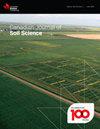Crop yields under no-till in Canada: Implications for soil organic carbon change
IF 1.5
4区 农林科学
Q4 SOIL SCIENCE
引用次数: 0
Abstract
Crop yields directly affect carbon inputs into soils. Tillage management can influence crop performance, and should be considered when quantifying soil organic carbon change (SOC), and thus net greenhouse gas emissions from croplands for national inventory reporting. We conducted a meta-analysis of the effects of no-tillage (NT) and conventional tillage (CT) on crop yields for multiple crop species, soil types and climatic regions of Canada. Yield response to NT varied between Western and Eastern Canada. Regardless of crop type, experiment duration, soil texture and residue management, experiments in Eastern Canada showed an average of 6% lower yields (p ≤ 0.005) under NT compared to CT. In Western Canada, crop type had an important effect on yields between NT and CT with wheat, canola and legumes exhibiting 10% (p ≤ 0.001), 7% (p ≤ 0.05) and 9% (p ≤ 0.05) higher yields on average under NT compared to CT, respectively. In Western Canada higher yields would be reflected in a similar scale of higher carbon inputs to NT systems. A recent meta-analysis of the effects of tillage management on SOC in Canada showed an 8% higher storage of SOC under NT systems, compared to CT, a difference limited to Western Canadian soils. Incorporating the effect of tillage on carbon inputs will lead to improvements in the accuracy of the effects of tillage management on SOC change in Canadian cropland. The activity data can be improved by applying weightings to the yield data by site specific assessment of tillage practices across Canada加拿大免耕作物产量:对土壤有机碳变化的影响
作物产量直接影响土壤的碳输入。耕作管理可以影响作物的生产性能,在量化土壤有机碳变化(SOC)时应予以考虑,从而为国家清单报告量化农田的温室气体净排放量。我们对免耕(NT)和常规耕作(CT)对加拿大多种作物品种、土壤类型和气候区域作物产量的影响进行了荟萃分析。加拿大西部和东部对NT的产量反应不同。无论作物类型、试验时间、土壤质地和残留物管理如何,在加拿大东部的试验中,NT比CT平均降低6%的产量(p≤0.005)。在加拿大西部,作物类型对旱作和连续旱作的产量有重要影响,旱作下小麦、油菜和豆类的平均产量分别比连续旱作高10% (p≤0.001)、7% (p≤0.05)和9% (p≤0.05)。在加拿大西部,更高的产量将反映在对北部系统的类似规模的更高的碳投入上。最近一项关于耕作管理对加拿大土壤有机碳影响的荟萃分析显示,与常规耕作系统相比,新耕作系统下有机碳储存量高出8%,这种差异仅限于加拿大西部土壤。纳入耕作对碳输入的影响将有助于提高耕作管理对加拿大农田有机碳变化影响的准确性。活动数据可以通过对加拿大各地耕作做法的具体地点评估对产量数据应用加权来改进
本文章由计算机程序翻译,如有差异,请以英文原文为准。
求助全文
约1分钟内获得全文
求助全文
来源期刊

Canadian Journal of Soil Science
农林科学-土壤科学
CiteScore
2.90
自引率
11.80%
发文量
73
审稿时长
6.0 months
期刊介绍:
The Canadian Journal of Soil Science is an international peer-reviewed journal published in cooperation with the Canadian Society of Soil Science. The journal publishes original research on the use, management, structure and development of soils and draws from the disciplines of soil science, agrometeorology, ecology, agricultural engineering, environmental science, hydrology, forestry, geology, geography and climatology. Research is published in a number of topic sections including: agrometeorology; ecology, biological processes and plant interactions; composition and chemical processes; physical processes and interfaces; genesis, landscape processes and relationships; contamination and environmental stewardship; and management for agricultural, forestry and urban uses.
 求助内容:
求助内容: 应助结果提醒方式:
应助结果提醒方式:


